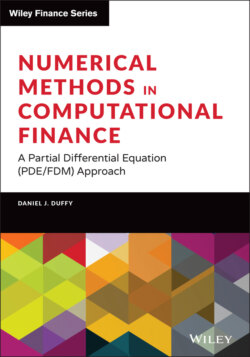Читать книгу Numerical Methods in Computational Finance - Daniel J. Duffy - Страница 39
2.3.1 Common Schemes
ОглавлениеWe now introduce a number of important and useful difference schemes that approximate the solution of Equation (2.1). These schemes will pop up all over the place in later chapters. Understanding how the schemes work in a simpler context will help you appreciate them when we tackle partial differential equations based on the Black–Scholes model. They also help in our understanding of notation, jargon, and syntax.
The main schemes are:
Explicit Euler
Implicit Euler
Crank–Nicolson (or Box scheme)
The trapezoidal method.
The explicit Euler method is given by:
(2.10)
whereas the implicit Euler method is given by:
(2.11)
Notice the difference: in Equation (2.10) the solution at level can be directly calculated in terms of the solution at level n, while in Equation (2.11) we must rearrange terms in order to calculate the solution at level .
The next scheme is called the Crank–Nicolson or box scheme, and it can be seen as an average of explicit and implicit Euler schemes. It is given as (see notation in Equation (2.7)):
(2.12)
It is useful to know that the three schemes can be merged into one generic scheme as it were by introducing a parameter (the scheme is sometimes called the Theta method):
(2.13)
and the special cases are given by:
(2.14)
The solution of Equation (2.13) is given by:
(2.15)
This equation is useful because it can be mapped to C++ code and will be used by other schemes by defining the appropriate value of the parameter .
Finally, the trapezoidal method is similar to Crank–Nicolson, but it takes a slightly different averaging mechanism:
(2.16)
